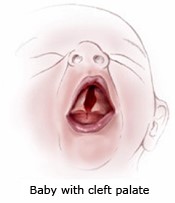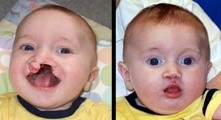Children's Emergency Department is now located in Children's Tower: 1001 E. Marshall Street.
Learn moreCleft lip and cleft palate are one of the most common birth differences in the U.S., affecting about one in every 600 babies born each year. This birth difference occurs during the first three months of pregnancy, often before a woman knows she’s pregnant.
A cleft is an opening or gap, that can occur when parts of lip and mouth do not come together (fuse) correctly before birth. A cleft may include a cleft of the lip only, a cleft of the palate only, or both cleft lip and palate. With a cleft lip, there’s an opening or gap in the upper lip and sometimes the gum behind the upper lip. With a cleft palate, the opening is in the roof of the mouth (called the palate). A cleft lip and palate includes both areas and is typically referred to as orofacial clefts.
A cleft lip can be on one side of the mouth (unilateral) or both sides (bilateral). It can go into the nose or stop at any point below. Having a cleft lip of any type changes the shape of the nose and may affect teeth.
Having a cleft can affect many aspects of a child’s life including their feeding, hearing, appearance, self-esteem, teeth and cause speech problems. While surgery to repair the cleft is important, a child’s care involves much more than surgery. This is why we provide a multidisciplinary team with expertise in the different areas that can be affected. At our Center for Craniofacial Care, experts from a wide range of specialties work together to address these varied issues, develop individualized treatment plans and provide the best care possible.
Teeth – When there’s a cleft in the gum, certain teeth may be affected. Sometimes there’s a missing tooth or an extra tooth near the cleft, and most children with a cleft lip will eventually need braces or other orthodontic treatment. Dental monitoring starting at an early age is an important part of care. Our team includes experienced pediatric dentists, orthodontists and oral/maxillofacial surgeons who participate in team evaluations and treatment.
Feeding – A cleft lip does not usually affect feeding, whether breastfeeding or bottle-feeding. For breastfeeding, you may need to try different positions to determine which position is easiest for your baby to nurse. A lactation consultant may be helpful with this. A baby with a cleft lip may swallow more air while feeding and burping your baby more frequently helps ensure the baby is comfortable.
Our team offers feeding consultation services to help with feeding issues and we recommend instructional feeding videos from the American Cleft Palate-Craniofacial Association for more on this topic.
In about two-thirds of children with clefts, there is no known cause. Sometimes, clefts may run in families or be part of a syndrome (a disorder that has a group of symptoms or features).
We’ve learned there are many things that can increase the chances of a baby having a cleft, but more still needs to be learned through scientific research. A genetics specialist can help families understand the possible causes of a cleft. It’s important for every family with a baby with a cleft lip, a cleft palate or both to meet with a geneticist (a medical doctor who specialists in conditions passed from parents to a child). We can help set up this appointment for you.
We do not routinely recommend the use of devices such as mouthpieces or surgically inserted pins for cleft lip repair. These devices are expensive, require a lot of work from families, and have not been proven to have a long-term benefit to children. Sometimes we recommend gentle taping of the lip at our first evaluation after the baby is born. In these cases, we provide the tape and teach parents and caregivers how to apply it.
A baby born with a cleft lip will need surgery to correct this condition. Our team recommends that every baby with cleft lip be evaluated while in the hospital, or as soon as possible after going home. Our surgeon will determine the earliest and safest time for lip repair. We repair the baby’s nose at the same time. A special technique is used so there are no stitches that will need to come out. Cleft lip repair may occur as early as six weeks of age, depending on growth, overall health and other factors.
Babies feed the same way before and after the operation, so you will not have to make any changes in your baby’s feeding. We do not use any arm restraints or equipment on the face after surgery. Babies usually go home the same day as the surgery and do not need to spend the night in the hospital. We encourage families to call us with any questions or concerns.
A child may need additional surgeries, procedures or treatments as they grow. These needs will be followed through continued team evaluations and related services.

Feeding – A baby with a cleft palate usually has a hard time feeding. Because there’s an opening between the mouth and nose, the baby cannot generate the suction needed to pull milk from the bottle or breast. This makes it difficult to breastfeed or use a regular bottle. An infant may look like they’re nursing and sucking, but they’re really using up a lot of energy and getting very little milk. (It’s like trying to drink through a straw with a hole in it.)
A baby with a cleft palate may also have milk come out of the nose when feeding. This is called “nasal regurgitation.” It is not dangerous and it does not mean your baby is choking. Holding your baby in a more upright position during feeding can help decrease the amount of milk that comes out of the nose. There is no need to use a bulb syringe to suck milk out of the nose – the nose clears and cleans itself.
Mothers are encouraged to express their breast milk with a breast pump. Breast milk can be used in bottle feeding with specially designed bottles and nipples. Our feeding specialist and team will evaluate your baby and determine which bottle and nipple is best suited for your child. We will also provide you with a starter supply and a list of resources where you can obtain more bottles and nipples. We recommend instructional feeding videos from the American Cleft Palate-Craniofacial Association for more on this topic.
Ears/hearing - The muscles in the palate normally help the ears drain and stay healthy. Because of the cleft palate, these muscles may not work properly and fluid can build up in the middle part of the ears. For this reason, a baby with a cleft palate often will not pass their newborn hearing screening. However, this does not mean a child cannot hear. Our ear, nose and throat doctor and audiologist (hearing specialist) monitor a child’s hearing as they grow and will perform further evaluation if needed.
Speech/language - A child’s speech may also be affected by the cleft palate. The palate separates the mouth from the nose area to allow normal-sounding speech. With a cleft palate, a baby’s babbling may sound like it’s coming through the nose. Some sounds are affected more than others – “mama” will sound clear, for example, but “dada” may sound more nasal (like “nana”). After a child has surgery to repair the palate the nasal sound will very likely improve.
The speech-language pathologists with our team follow each child closely and may recommend speech therapy. Sometimes more testing is needed. Our page on velopharyngeal insufficiency, the medical term for this issue, has more details about possible speech/language issues.

We ask each family with a newborn with a cleft palate to have their baby weighed once a week on the same set of scales for a period of time and call us with the weights so we can make sure feeding and growth is progressing well. Follow-up appointments will be scheduled to monitor progress and re-check feeding. We encourage families to call us with any questions or concerns.
Our surgeon will determine the earliest and safest time to repair the cleft palate, which is usually between six and 12 months of age. The surgeon does not take tissue from other parts of the body or use any artificial material to close the palate. During the reconstructive surgery, our ear, nose and throat doctor examines the baby’s ears and places tiny drainage tubes if necessary. An overnight stay is needed after the surgery for the child’s safety.
A child may need additional surgeries, procedures or treatments as they grow. These needs will be followed through continued team evaluations and related services.
Our center offers expert guidance on both surgical and non-surgical options, such as: